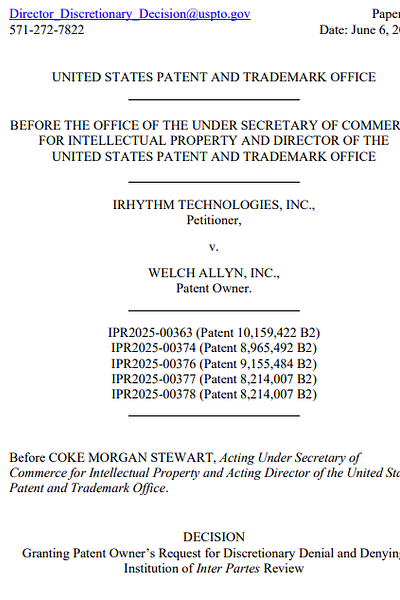Failure to Seek Early PTAB Review of the Patents Favors IPR Discretionary Denial
In iRhythm v. Welch Allen, a USPTO Director denial indicates that timing may be a new hurdle in the PTAB
Securing intellectual property rights often involves vigilance and timely action—now, challenging patent claims might, too. A recent decision by the United States Patent and Trademark Office (USPTO) Acting Director Coke Morgan Stewart highlights the importance of promptly challenging patents, particularly when a party has long been aware of the patent. This decision signals a cautionary note for those who might delay filing inter partes reviews (IPRs) until after litigation has commenced
The USPTO Director's recent decision in iRhythm Technologies, Inc. v. Welch Allyn, Inc emphasizes that awareness of a patent, even years before a formal challenge, can weigh heavily against the institution of an IPR. This underscores a broader need for potential petitioners to consider filing IPRs as soon as they become aware of a patent they may later wish to challenge, rather than deferring action until they are involved in district court litigation. It also presents a potentially strong avenue for patent owners hoping to avoid the PTAB’s review, in favor of district court.
Case Spotlight: iRhythm Technologies, Inc. v. Welch Allyn, Inc.
On June 6, 2025, the Acting Director of the USPTO issued a decision granting a patent owner's request for discretionary denial of institution in iRhythm v. Welch Allyn. The case involved five IPR petitions filed by iRhythm Technologies, Inc. against Welch Allyn, Inc. (IPR2025-00363, IPR2025-00374, IPR2025-00376, IPR2025-00377, and IPR2025-00378 for U.S. Pat. Nos. 10,159,422, 8,965,492, 9,155,484, 8,214,007, and 8,214,007, respectively).
Welch Allyn, the patent owner, filed a request for discretionary denial, arguing that iRhythm Technologies had been aware of at least one of the challenged patents since 2013, with the patent having been in force since 2012. iRhythm Technologies had cited the then-pending application for the patent in an Information Disclosure Statement (IDS) it filed in its own patent application.
While several arguments initially weighed against discretionary denial—such as the IPR's projected final written decision date being well before the district court trial date, and the petitioner's expert testimony appearing appropriate for explaining background knowledge rather than filling prior art gaps—the Director found the patent owner's argument regarding iRhythm's long-standing awareness persuasive.
The decision stated:
Nevertheless, Patent Owner argues that because one of the patents has been in force since as early as 2012 and Petitioner was aware of it as early as 2013—having cited the then-pending application that issued as the challenged patent in an Information Disclosure Statement Petitioner filed in its own patent application—settled expectations favor denial of institution. DD Req. 30–31. Patent Owner’s argument is persuasive. Petitioner’s awareness of Patent Owner’s applications and failure to seek early review of the patents favors denial and outweighs the above-discussed considerations.
The Director's decision concluded that the petitioner's awareness of the patent applications and failure to seek early review of the patents outweighed the other considerations.
While the decision does say that “the determination to exercise discretion to deny institution is based on a holistic assessment of all of the evidence and arguments presented,” the word “nevertheless” appears to imply that timing is huge. There was no mention of the Finitiv factors or a Sotera stipulation in the decision.
The USPTO's Interim Process for Discretionary Denials
This decision comes in the context of the USPTO's new Interim Process for Patent Trial and Appeal Board (PTAB) Workload Management. This interim process bifurcates decisions on IPR or post-grant review (PGR) institution into (i) discretionary considerations and (ii) merits and other statutory considerations.
The USPTO allows parties to file separate briefing for each. The Director, in consultation with at least three PTAB judges, then determines whether discretionary denial is appropriate. If not, the petition is referred to a three-member PTAB panel for a decision on the merits.
This new interim process aims to manage PTAB workload, reduce ex parte appeal pendency, and ensure consistency in institution decisions. The process is effective immediately for cases where a patent owner preliminary response has not yet been filed.
Awareness as a Factor in Discretionary Denials
The iRhythm decision suggests that awareness of a patent, particularly when demonstrated by formal filings like an IDS, can be a significant factor in discretionary denials.
While this specific decision is not necessarily precedential in a broad sense, it offers insight into the Director's approach to discretionary denials under the new interim process.
Beyond citing a patent in an IDS, patent owners may be able to demonstrate a petitioner's long-term awareness through various other means. This could include, but is not limited to:
Prior communications: Correspondence, licensing discussions, or cease-and-desist letters exchanged between the parties that reference the patent.
Related litigation: Prior involvement in other lawsuits or administrative proceedings where the patent was discussed or at issue.
Public statements or disclosures: Public comments, press releases, or investor presentations by the petitioner that discuss the patent or the technology it covers.
Industry knowledge: Evidence that the patent was well-known within a particular industry segment where the petitioner operates.
The argument that citing a specification in an IDS years prior indicates a tacit approval of validity or a comprehensive awareness of the eventual claims may be tought to swallow. However, the iRhythm decision indicates that such actions can contribute to a finding of long-term awareness that weighs against institution.
When an IPR is filed, patent owners will undoubtedly seek to leverage any verifiable instances of a petitioner's knowledge of the patent, regardless of the level of detail, to support discretionary denial arguments. There is a page limit, but demonstrating early awareness could save a trip to the PTAB.
For those who plan to file or frequently file IPRs, it may be prudent to consider the ownership and prosecution history of the references relied upon. Citing a reference held by an NPE might be a roadblock to challenge to that patent later. Likewise, strategy for choosing a petitioner from multi-party litigation could come down to “awareness” of the patent at issue.
Outcome
It’s important to note that the consequence of the “failure to seek early review of the patents” is that the validity challenge happens at District Court, not in an IPR. The PTAB stats still speak for themselves as a favorable venue for validity challenges and why a petitioner might prefer an AIA panel.
In its Response, iRhythm argued that inaction by the patent owner to assert the patents-at-issue created a "settled" expectation that iRhythm's products were not implicated by the '422 patent. While this laches-type assertion may feel about as reasonable as citing art in an IDS establishing an awareness timeline, it appears to be more persuasive as to why the validity challenge should be litigated instead of remaining at the PTAB.
iRhythm also noted in the Response that it could not have anticipated repeated filing of broadening continuations, which they also felt were problematic/invalid. Again, that’s courtroom talk. That sounds more like “we were waiting to fight it out in court if they threw the first punch” than “we told the USPTO about our validity concerns the moment we saw it.”
It could also be an acknowledgement of early awareness. One might perceive it as a concerning policy when the USPTO invalidates a patent claim that has been asserted, licensed, and actively in use for over a decade after grant.
Either way, the argument of waiting for an assertion before filing an IPR might not hold water in a decision concerning discretionary denial. In the end, “awareness” won.
Conclusion
Timing can be everything in the nuanced world of patent challenges. The decision in iRhythm Technologies, Inc. v. Welch Allyn, Inc., and the broader context of the USPTO's interim process for discretionary denials, suggests that a petitioner's long-term awareness of a patent will be a significant factor.
IP owners, patent practitioners, and inventors will likely continue to monitor future discretionary denial decisions from the Director to identify strong factors that may persuade the USPTO to grant or deny institution.
The recent discretionary denials could signal a shift at the USPTO from “sure, we’ll review that patent again, for a price” to “why didn’t you tell us it was invalid 10 years ago?”
Disclaimer: This is provided for informational purposes only and does not constitute legal or financial advice. To the extent there are any opinions in this article, they are the author’s alone and do not represent the beliefs of his firm or clients. The strategies expressed are purely speculation based on publicly available information. The information expressed is subject to change at any time and should be checked for completeness, accuracy and current applicability. For advice, consult a suitably licensed attorney and/or patent professional.




